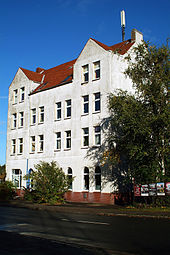Tönniesberg (Hanover)
The Tönniesberg in Hannover is the Hanoverian districts Bornum and Ricklingen situated mountain , the 77 meters at its highest point about sea level rises. The ridge is located between the Fischerhof freight yard , Lindener Berg and Mühlenberg .
history
The name was derived "probably from a chapel dedicated to Saint Anthony ". At the end of the 18th century the elevation was still called Tönjes Berg .
Although there was a great boom in the Hanoverian residential construction in the 1920s , there was a massive increase in homelessness, especially in the "crisis years" of the Weimar Republic . Your housing shortage was triggered by the from the First World War onset German hyperinflation ; then through the Great Depression of 1929, which also resulted in tens of thousands of people in Hanover becoming unemployed. Many impoverished families could no longer pay their apartment rents and were evicted by the landlords . Thus were the Tönniesberg - similar to the Welfenplatz - temporary shelter for hundreds of families set up. The primitive dwellings of the Tönniesberg settlement consisted mainly of discarded railway wagons , in which up to 600 people temporarily lived. Each “resident” was entitled to a maximum of 4 square meters of covered living space. The families also suffered from drafts , moisture and mold , and in 1933, at the beginning of the Nazi era , “144 families with 263 children in 50 railway wagons” lived in the Tönniesberg settlement.
The street "Am Tönniesberg" leading over the Tönniesberg marks the border of the districts Bornum and Ricklingen. The road was part of Hamelner Chaussee until the expressways were built . After the Second World War , the new Hanover wholesale market was built on Tönniesberg due to its convenient location to the freight station and express routes such as the Westschnellweg .
literature
- Angela Dinghaus, Bettina Korff: “On the path to morality and order”. Urban homelessness: Frauenhort in Fernroderstrasse, Tönniesberg and Welfenasyl , in Adelheid von Saldern et al. : Everyday life between Hindenburg and Haarmann. Another city guide through Hanover in the 1920s , publisher: Geschichtswerkstatt Hannover, Hamburg: VSA-Verlag, 1987, ISBN 3-87975-397-0 , pp. 105–114
- Sid Auffarth : “New building” and poor housing in Hanover. In: Sid Auffarth, Adelheid von Saldern (ed.), Richard Birkefeld (collabor.): Old and new living. Linden and Hanover in the early 20th century , Seelze-Velber: Kallmeyer, 1992, ISBN 3-7800-5256-3 , p. 124ff.
- Eva Benz-Rababah : Tönniesberg. In: Klaus Mlynek, Waldemar R. Röhrbein (eds.) U. a .: City Lexicon Hanover . From the beginning to the present. Schlütersche, Hannover 2009, ISBN 978-3-89993-662-9 , p. 625.
Web links
- Tönniesberg in the catalog of the German National Library
- Aerial photo - Photo from 1945 by the American armed forces photographer Margaret Bourke-White with bomb craters on Tönniesberg
- Oliver Nöthel (responsible): toenniesberg.de/ , website with "District information on Bornum and Mühlenberg "
Individual evidence
- ↑ a b c d Eva Benz-Rababah: Tönniesberg (see literature)
- ↑ Oliver Nöthel (responsible): Tönniesberg (see under the section Weblinks )
- ↑ a b Weimar Republic and National Socialism. In: Klaus Mlynek , Waldemar R. Röhrbein : History of the City of Hanover , Volume 2: From the beginning of the 19th century to the present , Hanover: Schlütersche Verlagsgesellschaft, 1994, ISBN 3-87706-364-0 , here especially p. 438; online through google books
- ^ Waldemar R. Röhrbein: Großmarkt Hannover GmbH. In: Stadtlexikon Hannover , p. 236
Coordinates: 52 ° 21 ' N , 9 ° 42' E
